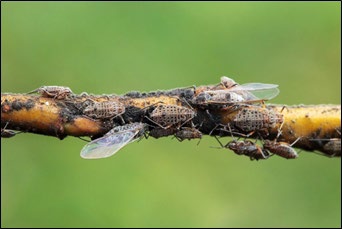PESTS AND DISEASES OF FORESTRY IN NEW ZEALAND
Giant Willow Aphid Update
Scion is the leading provider of forest-related knowledge in New Zealand
Formerly known as the Forest Research Institute, Scion has been a leader in research relating to forest health for over 50 years. The Rotorua-based Crown Research Institute continues to provide science that will protect all forests from damage caused by insect pests, pathogens and weeds. The information presented below arises from these research activities.
From Forest Health News No. 268, July 2016.
The giant willow aphid (Tuberolachnus salignus) was first found in New Zealand (Auckland) in December 2013 (FH News 246). Within a few months it was widespread throughout the country. In Australia, it was first found in March 2014 and is recorded in Tasmania, New South Wales, Australian Capital Territory and Victoria. Its usual hosts are willows and poplars and it has been found on a very wide range of willows species and hybrids in New Zealand.

The aphids aggregate and can form dense colonies on infested trees. Somewhat unusually for aphids, they feed on stems rather than on twigs and foliage. In the United Kingdom, the pest has significantly reduced growth of willows and is known to be capable of killing willows over 10 m tall. Studies have shown that root development is reduced and aphid attack may predispose willows to abiotic stress factors such as frost or drought.
In New Zealand, heavy colonisation of willows has been seen in many parts of the country. This year, young trees in the National Willow Collection in Palmerston North have died because of aphid attack. Young and old trees have been blackened by the sooty mould that develops on the large volumes of honeydew that the aphids excrete. Standing underneath an infested willow, the honeydew can be felt like light rain. This honeydew has several unwanted effects. It coats not only willow foliage but anything else within range, for example sheep and machinery. The carbon rich honeydew may change soil chemistry. Significant increases in wasp populations have been noted near infested willows, not only causing problems for people and domestic animals, but also increasing bee mortality. Honeydew is collected by bees and processed into honey, but this honey has several unattractive characteristics. Its taste may be less appreciated by consumers than other honey and, more importantly, it is extremely difficult to extract from the hives. This has resulted in significant production loss for some beekeepers.

From June 19 to 21, the Apiculture NZ National Conference was held in Rotorua. Stephanie Sopow presented, describing the giant willow aphid, the damage caused, and what Scion is proposing to reduce its effect on willows and on primary industries. This month, Scion is initiating a biological control programme, starting with an application to import a parasitic wasp and preliminary research to develop protocols for rearing the giant willow aphid in containment. We also hope to collect native aphids that may potentially be attacked by the control agent and start colonies in containment so when the biological control agent is imported we are ready to start non target host testing. This work will be financed by MPI’s Sustainable Farming Fund, Scion core funding and direct and in-kind support from many stakeholders.
Stephanie Sopow (Scion)
This information is intended for general interest only. It is not intended to be a substitute for specific specialist advice on any matter and should not be relied on for that purpose. Scion will not be liable for any direct, indirect, incidental, special, consequential or exemplary damages, loss of profits, or any other intangible losses that result from using the information provided on this site.
(Scion is the trading name of the New Zealand Forest Research Institute Limited.)

 Farm Forestry New Zealand
Farm Forestry New Zealand

